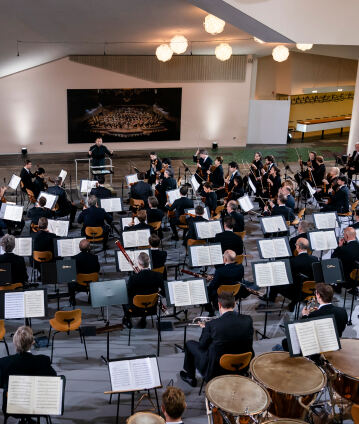2021 Europakonzert from Berlin with Kirill Petrenko

As in 2020, the Berliner Philharmoniker and Kirill Petrenko again gave their 2021 Europakonzert in the Philharmonie Berlin, due to the corona pandemic – this time in the foyer of the building. Its special architecture is an invitation to present the music spatially: Blacher’s festive Fanfare, Ives’s enigmatic Unanswered Question, Mozart’s serene Notturno and Penderecki’s spherical Emanations consciously rely on the effect of spatial sound. Also in the Europakonzert programme: Pyotr Ilyich Tchaikovsky’s charming Orchestral Suite No. 3 and John Adams’s witty piece Short Ride in a Fast Machine.
Wolfgang Stresemann, the orchestra’s long-time general manager, wrote about the foyer of the Philharmonie Berlin, which is notable for its numerous staircases: “Nothing is static in this foyer of the Philharmonie; it only serves function. Everything is alive and seems to be in constant motion. One could almost speak of an architectural ʻperpertuum mobileʼ”. Ideal conditions, then, for the wild final piece of the programme, John Adams’s Short Ride in a Fast Machine, in which the music does not stand still for a second either. The unusual spatial-sound effects of the other programme items also benefitted from the specific architectural conditions of the foyer: In his Emanations, Krzysztof Penderecki allows two separate instrumental ensembles to communicate with each other, while Charles Ives allows three in the famous study The Unanswered Question, and Mozart even allows four in his Notturno, which is full of witty echo effects.
The Europakonzert opens with Boris Blacher’s Fanfare for the Opening of the Philharmonie, which Herbert von Karajan conducted at the building’s inaugural concert on 15 October 1963. The main symphonic work on the programme is Tchaikovsky’s Orchestral Suite No. 3, whose premiere was conducted by Hans von Bülow, later chief conductor of the Berliner Philharmoniker, in St Petersburg in 1885. In it, an elegy and a set of variations as a finale frame a waltz and a scherzo. With a programme that alternates between frenzied movement and meditation, the reflective and the dance-like, and melancholy and optimism, Kirill Petrenko and the Berliner Philharmoniker presented their audience with an entertaining Europakonzert full of hope, even in the difficult pandemic year of 2021.
© 2021 EuroArts Music International
Category
Artists
Our recommendations
- 2020 Europakonzert from the Philharmonie Berlin with Kirill Petrenko
- 2023 Europakonzert from Barcelona with Kirill Petrenko
- 1996 Europakonzert from St Petersburg with Claudio Abbado
- 1993 Europakonzert from London with Bernard Haitink and Frank Peter Zimmermann
- The 1999 Europakonzert in Krakow with Bernard Haitink, Emanuel Ax and Christine Schäfer
- Daniel Barenboim conducts the 2014 Europakonzert in Berlin